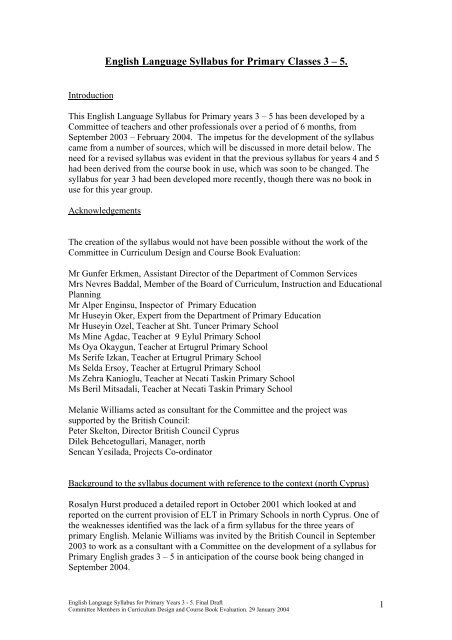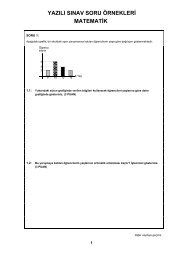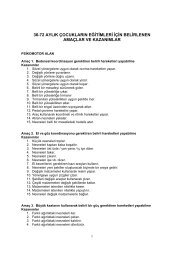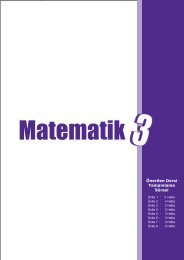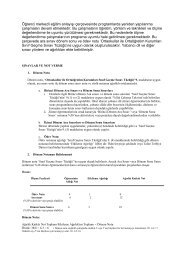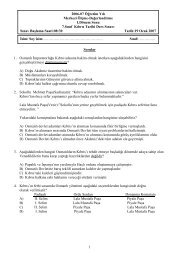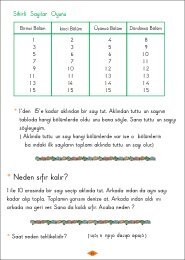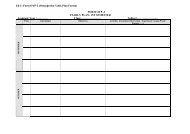English Language Syllabus for Primary Classes 3 – 5.
English Language Syllabus for Primary Classes 3 – 5.
English Language Syllabus for Primary Classes 3 – 5.
You also want an ePaper? Increase the reach of your titles
YUMPU automatically turns print PDFs into web optimized ePapers that Google loves.
<strong>English</strong> <strong>Language</strong> <strong>Syllabus</strong> <strong>for</strong> <strong>Primary</strong> <strong>Classes</strong> 3 <strong>–</strong> <strong>5.</strong><br />
Introduction<br />
This <strong>English</strong> <strong>Language</strong> <strong>Syllabus</strong> <strong>for</strong> <strong>Primary</strong> years 3 <strong>–</strong> 5 has been developed by a<br />
Committee of teachers and other professionals over a period of 6 months, from<br />
September 2003 <strong>–</strong> February 2004. The impetus <strong>for</strong> the development of the syllabus<br />
came from a number of sources, which will be discussed in more detail below. The<br />
need <strong>for</strong> a revised syllabus was evident in that the previous syllabus <strong>for</strong> years 4 and 5<br />
had been derived from the course book in use, which was soon to be changed. The<br />
syllabus <strong>for</strong> year 3 had been developed more recently, though there was no book in<br />
use <strong>for</strong> this year group.<br />
Acknowledgements<br />
The creation of the syllabus would not have been possible without the work of the<br />
Committee in Curriculum Design and Course Book Evaluation:<br />
Mr Gunfer Erkmen, Assistant Director of the Department of Common Services<br />
Mrs Nevres Baddal, Member of the Board of Curriculum, Instruction and Educational<br />
Planning<br />
Mr Alper Enginsu, Inspector of <strong>Primary</strong> Education<br />
Mr Huseyin Oker, Expert from the Department of <strong>Primary</strong> Education<br />
Mr Huseyin Ozel, Teacher at Sht. Tuncer <strong>Primary</strong> School<br />
Ms Mine Agdac, Teacher at 9 Eylul <strong>Primary</strong> School<br />
Ms Oya Okaygun, Teacher at Ertugrul <strong>Primary</strong> School<br />
Ms Serife Izkan, Teacher at Ertugrul <strong>Primary</strong> School<br />
Ms Selda Ersoy, Teacher at Ertugrul <strong>Primary</strong> School<br />
Ms Zehra Kanioglu, Teacher at Necati Taskin <strong>Primary</strong> School<br />
Ms Beril Mitsadali, Teacher at Necati Taskin <strong>Primary</strong> School<br />
Melanie Williams acted as consultant <strong>for</strong> the Committee and the project was<br />
supported by the British Council:<br />
Peter Skelton, Director British Council Cyprus<br />
Dilek Behcetogullari, Manager, north<br />
Sencan Yesilada, Projects Co-ordinator<br />
Background to the syllabus document with reference to the context (north Cyprus)<br />
Rosalyn Hurst produced a detailed report in October 2001 which looked at and<br />
reported on the current provision of ELT in <strong>Primary</strong> Schools in north Cyprus. One of<br />
the weaknesses identified was the lack of a firm syllabus <strong>for</strong> the three years of<br />
primary <strong>English</strong>. Melanie Williams was invited by the British Council in September<br />
2003 to work as a consultant with a Committee on the development of a syllabus <strong>for</strong><br />
<strong>Primary</strong> <strong>English</strong> grades 3 <strong>–</strong> 5 in anticipation of the course book being changed in<br />
September 2004.<br />
<strong>English</strong> <strong>Language</strong> <strong>Syllabus</strong> <strong>for</strong> <strong>Primary</strong> Years 3 - <strong>5.</strong> Final Draft<br />
Committee Members in Curriculum Design and Course Book Evaluation. 29 January 2004<br />
1
Melanie Williams worked with the Committee <strong>for</strong> an initial four days in September<br />
2003. The focus at this time was on How Young Learners Learn and <strong>Syllabus</strong> Design.<br />
During the following four months the Committee worked on the syllabus document,<br />
with feedback from Melanie on materials completed. In January 2004, Melanie<br />
returned to Cyprus to finalize the syllabus document with the Committee. This is the<br />
finalized document.<br />
The syllabus has been developed to reflect the teaching hours in grades 3 <strong>–</strong> 5:<br />
In Grade 3 <strong>English</strong> is taught <strong>for</strong> 2 hours a week.<br />
In Grades 4 and 5 <strong>English</strong> is taught <strong>for</strong> 5 hours a week<br />
Rationale with reference to syllabus design<br />
It was decided that a ‘hybrid’ syllabus would be the most appropriate <strong>for</strong> the context.<br />
This syllabus is a principled mix of a product-oriented syllabus, where the focus is on<br />
outcomes and products, and a process oriented syllabus, where the focus is on the<br />
process of learning in the classroom. A typical product oriented syllabus tends to be<br />
structure or function focused, with learners’ success being measured by their ability to<br />
use the structures or functions learned. A process-oriented syllabus, on the other hand,<br />
tends to focus on the tasks that are used in the classroom, the process of learning,<br />
through which the learners learn the language and through which they are able to<br />
engage in meaningful interaction.<br />
In this syllabus there are suggested lists of structures, functions, topics and vocabulary<br />
<strong>for</strong> each level as well as suggested activities.<br />
The main difference between this syllabus and the one that preceded it are the<br />
Per<strong>for</strong>mance Objectives. Per<strong>for</strong>mance Objectives define learning outcomes by stating<br />
what a learner will be able to do with the language at the end of a given period,<br />
there<strong>for</strong>e making the prime focus language competence rather than knowledge. This is<br />
particularly important at <strong>Primary</strong> level where learning is very much a holistic process<br />
and where learners want and need to use the language <strong>for</strong> meaningful interaction as<br />
much as possible. The focus at <strong>Primary</strong> level is not on learning grammatical<br />
structures.<br />
One other aspect which it is important to emphasize is that of ‘accuracy’. The<br />
Per<strong>for</strong>mance Objectives make reference to ‘a basic level of accuracy’ or ‘a<br />
satisfactory level of accuracy’. This is because accuracy is only one of components of<br />
‘communicative competence’, others being, <strong>for</strong> example, appropriacy, range, fluency.<br />
Per<strong>for</strong>mance Objectives also enable each learner to be assessed against a set of<br />
criteria (more precise targets derived from the objectives) rather than being assessed<br />
against other learners. Per<strong>for</strong>mance Objectives further enable teachers to construct<br />
and manage continuous and in<strong>for</strong>mal assessment instruments.<br />
The Per<strong>for</strong>mance Objectives in this syllabus are divided into skills and grades. There<br />
are sets of objectives <strong>for</strong> each language skill at each level. The objectives are graded,<br />
in that the ones at the top of the list <strong>for</strong> each grade are likely to be the ones learners<br />
achieve first. However, learning is cyclical process, it is not lock-step or linear and<br />
<strong>English</strong> <strong>Language</strong> <strong>Syllabus</strong> <strong>for</strong> <strong>Primary</strong> Years 3 - <strong>5.</strong> Final Draft<br />
Committee Members in Curriculum Design and Course Book Evaluation. 29 January 2004<br />
2
teachers should expect learners to seem to <strong>for</strong>get one thing they have learned as they<br />
are confronted with something new.<br />
Rationale with reference to language learning<br />
The syllabus emphasizes language <strong>for</strong> communication, and learners’ involvement in<br />
meaningful and relevant activities. A syllabus is not a methodological document:<br />
however, the use of Per<strong>for</strong>mance Objectives which focus on learning and state aspects<br />
of communicative competence will, it is hoped, tend to promote more communicative<br />
teaching.<br />
Rationale with reference to young learners<br />
Children learn by making sense of their environment, by being physically and<br />
mentally involved in what they are learning and when they can see concrete and real<br />
outcomes. Children of primary age have not reached a staged of cognitive<br />
development where they are able to think in the abstract and analyze the grammar of<br />
language. <strong>Primary</strong> learners can seem to learn ef<strong>for</strong>tlessly as they become immersed in<br />
what they are doing and when they are interested in topics and activities. The topics in<br />
this syllabus are all ones that will be relevant to the children’s world and about which<br />
they will have plenty to say. The Per<strong>for</strong>mance Objectives describe activities that<br />
children will want to do and will be doing the classroom.<br />
Rationale with reference to the text book<br />
This syllabus is not designed to be prescriptive. A syllabus document should be<br />
flexible enough so that it can be matched to a number of course materials. This<br />
syllabus is flexible in that:<br />
• Per<strong>for</strong>mance Objectives state outcomes but not content;<br />
• Structures and Functions are given <strong>for</strong> each grade but are not listed in any<br />
particular order;<br />
• Examples of Functions are examples only;<br />
• Topics are those found in primary course books;<br />
• There is some key vocabulary but most of this would arise in relation to the<br />
topics;<br />
• Activities are suggested activities only.<br />
While structures and functions are listed <strong>for</strong> each grade in the syllabus, this separation<br />
is not absolute. There<strong>for</strong>e, it would be perfectly possible to select a course book which<br />
included a structure in grade 3 which is listed in this syllabus in grade 4.<br />
Benchmarking<br />
The Outcomes at the end of Grade 5 match with descriptors of A1 within the<br />
Common European Framework of Reference <strong>for</strong> <strong>Language</strong>s. The decision to<br />
benchmark the syllabus at this level was made <strong>for</strong> the following reasons:<br />
<strong>English</strong> <strong>Language</strong> <strong>Syllabus</strong> <strong>for</strong> <strong>Primary</strong> Years 3 - <strong>5.</strong> Final Draft<br />
Committee Members in Curriculum Design and Course Book Evaluation. 29 January 2004<br />
3
a) This is the level which many European Countries have adopted <strong>for</strong> <strong>English</strong> at<br />
the end of <strong>Primary</strong> Education;<br />
b) Linking the syllabus to the Common European Framework would give the<br />
syllabus credibility and international currency;<br />
c) There are international tests, <strong>for</strong> example Cambridge ESOL Young Learner<br />
<strong>English</strong> Tests, which assess learners per<strong>for</strong>mance at A1 level;<br />
d) This benchmarking gives the Secondary <strong>Syllabus</strong> a definite starting point.<br />
Structure and Organization of the syllabus.<br />
The syllabus is organized in the following way:<br />
For each grade there are:<br />
• Per<strong>for</strong>mance Objectives in Listening, Speaking, Reading, Writing<br />
• Structures<br />
• Functions and Examples<br />
• Topics<br />
• Key Vocabulary<br />
• Suggested Activities<br />
Assessment<br />
As mentioned above, the revision of a syllabus demands that assessment of learning<br />
should also be revised.<br />
This syllabus, by specifying Per<strong>for</strong>mance Objectives and learning outcomes is very<br />
different from the previous syllabus and will require major re<strong>for</strong>m of assessment and<br />
testing at <strong>Primary</strong> Level in <strong>English</strong>. It will demand a move away from discrete item<br />
tests to continuous, in<strong>for</strong>mal assessment linked to criteria derived from the<br />
Per<strong>for</strong>mance Objectives. Learners will need to be assessed individually against these<br />
criteria, perhaps with Portfolio assessment becoming the means of monitoring and<br />
recording learners’ progress.<br />
Classroom based assessment will be carried out on a continuous basis. Activities <strong>for</strong><br />
assessment will be the ones that learners normally do in the classroom, <strong>for</strong> example<br />
quizzes, matching activities, games and so on. Learners will be assessed doing<br />
classroom activities: they would not always be set special, different assessment<br />
activities. Teachers will use a checklist which directly links to the objectives of the<br />
syllabus and will be observing each learner to monitor progress - the extent to which<br />
s/he was moving towards certain objectives. Samples of learner’s work will also be<br />
collected, oral as well as written, and assembled in a file or portfolio. Since the<br />
objectives of the syllabus cover all four skills, assessment will also be of all four<br />
skills.<br />
External assessment. Any external assessment, <strong>for</strong> example to measure learners’<br />
progress nationally at the end of primary education, will be in the <strong>for</strong>m of more<br />
<strong>for</strong>mal tests. However, these tests will also need to assess learners’ progress with<br />
reference to the objectives and assess in all four skills.<br />
Current tests will not be suitable <strong>for</strong> this revised syllabus.<br />
<strong>English</strong> <strong>Language</strong> <strong>Syllabus</strong> <strong>for</strong> <strong>Primary</strong> Years 3 - <strong>5.</strong> Final Draft<br />
Committee Members in Curriculum Design and Course Book Evaluation. 29 January 2004<br />
4
Broad Aims<br />
The broad aims of the syllabus are to:<br />
• Encourage and enable pupils to communicate and interact in <strong>English</strong> in<br />
various situations (within the limits of this syllabus)<br />
• Develop pupils’ ability in all four <strong>English</strong> language skills (listening, speaking,<br />
reading and writing)<br />
• Develop in pupils a positive attitude towards <strong>English</strong> and towards other<br />
languages and cultures<br />
• Promote pupils’ cognitive and social development<br />
• Support pupil-teacher interaction<br />
• Cater <strong>for</strong> pupils’ different learning styles and intelligences by providing a<br />
variety of activities and materials<br />
• Develop a limited range of language learning strategies<br />
<strong>English</strong> <strong>Language</strong> <strong>Syllabus</strong> <strong>for</strong> <strong>Primary</strong> Years 3 - <strong>5.</strong> Final Draft<br />
Committee Members in Curriculum Design and Course Book Evaluation. 29 January 2004<br />
5
Objectives: Pupils will be able to:<br />
Listening Speaking Reading Writing<br />
Class 3<br />
• Understand and respond to very simple<br />
classroom instructions<br />
• Understand and respond to very simple<br />
questions on familiar topics<br />
• Listen to and understand simple songs and<br />
rhymes<br />
• Listen <strong>for</strong> key specific in<strong>for</strong>mation in very<br />
short, simple texts on familiar topics<br />
• Recognize and produce the sounds of <strong>English</strong><br />
as distinct from those of Turkish<br />
• Ask <strong>for</strong> and give limited personal in<strong>for</strong>mation<br />
• Speak with basic pronunciation and a basic<br />
level of accuracy<br />
• Talk about familiar topics using short, simple<br />
utterances<br />
• Ask and answer a limited range of simple<br />
questions about their needs in the classroom<br />
• Read and understand familiar words and phrases<br />
• Identify the letters of the alphabet and develop<br />
spelling<br />
• Read and understand very simple sentences and<br />
questions<br />
• Use a picture dictionary<br />
• Read and understand very short, simple texts on<br />
familiar topics<br />
• Write simple words and phrases legibly<br />
• Spell simple words with a basic level of<br />
accuracy<br />
• Use basic punctuation accurately<br />
• Write and respond to very simple<br />
questions about familiar topics<br />
• Write one or two simple sentences about<br />
familiar topics<br />
Class 4<br />
• Understand and respond to simple<br />
classroom instructions<br />
• Understand and respond to simple<br />
questions on familiar topics<br />
• Understand the general idea in short,<br />
simple texts on familiar topics<br />
• Listen <strong>for</strong> key specific in<strong>for</strong>mation in<br />
short, simple texts on familiar topics<br />
• Give simple instructions and make simple<br />
requests<br />
• Talk about familiar topics using short<br />
utterances<br />
• Speak with satisfactory pronunciation and a<br />
satisfactory level of accuracy<br />
• Ask and answer simple questions about<br />
familiar topics<br />
• Read and understand the general idea in short,<br />
simple texts about familiar topics<br />
• Identify the main characters and places in a<br />
short, simple story<br />
• Use a picture dictionary<br />
• Read a limited range of short, simple texts on<br />
familiar topics and identify specific in<strong>for</strong>mation<br />
• Write a limited range of text types such<br />
as cards, letters and simple projects<br />
• Write legibly and use satisfactory<br />
punctuation and spelling<br />
• Write dictated paragraphs of up to 8<br />
sentences about familiar topics<br />
• Write a paragraph of up to 10 sentences<br />
about a familiar topic<br />
Class 5<br />
• Understand and respond to classroom<br />
instructions<br />
• Understand and respond to questions on<br />
familiar topics<br />
• Listen to and understand the main idea of a<br />
short text<br />
• Listen <strong>for</strong> specific in<strong>for</strong>mation in short<br />
texts on familiar topics<br />
• Give instructions and make requests<br />
appropriately<br />
• Ask and answer questions about familiar topics<br />
• Speak with reasonable pronunciation and a<br />
reasonable level of accuracy<br />
• Talk in some detail about familiar topics<br />
• Tell simple stories<br />
• Read and understand the main idea of a short<br />
reading text<br />
• Identify the main characters, places and the<br />
progress of a short story<br />
• Use a dictionary / the internet <strong>for</strong> reference<br />
• Read a range of short texts on familiar topics<br />
and identify specific in<strong>for</strong>mation<br />
• Write legibly and use accurate<br />
punctuation and spelling<br />
• Write dictated paragraphs of up to 15<br />
sentences<br />
• Write a range of short texts such as<br />
emails, invitations, poems, projects and<br />
recipes<br />
• Write several paragraphs as appropriate<br />
to text type about familiar topics<br />
<strong>English</strong> <strong>Language</strong> <strong>Syllabus</strong> <strong>for</strong> <strong>Primary</strong> Years 3 - <strong>5.</strong> Final Draft<br />
Committee Members in Curriculum Design and Course Book Evaluation. 30 January 2004<br />
6
Class 3<br />
Listening Speaking Reading Writing<br />
• Understand and<br />
respond to very simple<br />
classroom instructions<br />
• Understand and<br />
respond to very simple<br />
questions on familiar<br />
topics<br />
• Listen to and<br />
understand simple<br />
songs and rhymes<br />
• Listen <strong>for</strong> key specific<br />
in<strong>for</strong>mation in very<br />
short, simple texts on<br />
familiar topics<br />
• Recognize and produce<br />
the sounds of <strong>English</strong> as<br />
distinct from those of<br />
Turkish<br />
• Ask <strong>for</strong> and give limited<br />
personal in<strong>for</strong>mation<br />
• Speak with basic<br />
pronunciation and a<br />
basic level of accuracy<br />
• Talk about familiar<br />
topics using short,<br />
simple utterances<br />
• Ask and answer a<br />
limited range of simple<br />
questions about their<br />
needs in the classroom<br />
• Read and understand<br />
familiar words and<br />
phrases<br />
• Identify the letters of<br />
the alphabet and<br />
develop spelling<br />
• Read and understand<br />
very simple sentences<br />
and questions<br />
• Use a picture dictionary<br />
• Read and understand<br />
very short, simple texts<br />
on familiar topics<br />
• Write simple words<br />
and phrases legibly<br />
• Spell simple words<br />
with a basic level of<br />
accuracy<br />
• Use basic<br />
punctuation<br />
accurately<br />
• Write and respond to<br />
very simple<br />
questions about<br />
familiar topics<br />
• Write one or two<br />
simple sentences<br />
about familiar topics<br />
FUNCTIONS STRUCTURES EXAMPLES<br />
Greetings and saying<br />
farewell<br />
Formulaic phrases Hello, good morning, good afternoon, goodnight,<br />
goodbye.<br />
How are you? I am (I’m) fine, thank you.<br />
Responding to basic Imperatives (positive) Look, listen, open the door, etc.<br />
classroom <strong>English</strong><br />
Giving and asking <strong>for</strong><br />
personal in<strong>for</strong>mation<br />
Identifying things in the<br />
classroom<br />
What? How old ?<br />
My / your<br />
Verb: to be<br />
I / you + contractions<br />
A / an<br />
This<br />
Inverted questions<br />
Short answers:<br />
Yes it is / No it isn’t.<br />
What is (What’s) your name?<br />
My name is (name’s) ____.<br />
What is your surname? My surname is ___.<br />
How old are you? I am (I’m) ___ years old.<br />
What is this? It is a pen, book, ruler, etc.<br />
Is it a ___? Yes, it is. / No, it is not (isn’t).<br />
Identifying colours. Adjectives: colours What colour is this? It is (It’s) _____.<br />
Specifying number<br />
Asking and talking<br />
about ages.<br />
Identifying friends and<br />
members of the family.<br />
Describing people.<br />
Expressing possession.<br />
Talking about location.<br />
How many + plural<br />
nouns<br />
Numbers 1 <strong>–</strong> 20<br />
Inverted questions<br />
Short answers: Yes I<br />
am / No, I’m not.<br />
Verb: to be<br />
S/he + contractions<br />
Adjectives / nouns<br />
Short answers: Yes<br />
s/he is / No, s/he isn’t<br />
Possessive adjectives:<br />
my, your, his, her<br />
Where?<br />
Prepositions of place<br />
In, on, under<br />
How many books? Two books.<br />
Are you five years old?<br />
Yes, I am. / No, I am not. (I’m not)<br />
This is Ali. He is (He’s) seven years old.<br />
He is (He’s) a pupil.<br />
This is Ayse. She is (She’s) eight years old.<br />
She is (She’s) my sister.<br />
Is Ali tall / doctor/ three years old?<br />
Is Ayse happy / a teacher?<br />
This is my book. This is her pen.<br />
Where is (Where’s) the book? On the table.<br />
<strong>English</strong> <strong>Language</strong> <strong>Syllabus</strong> <strong>for</strong> <strong>Primary</strong> Years 3 - <strong>5.</strong> Final Draft<br />
Committee Members in Curriculum Design and Course Book Evaluation. 30 January 2004<br />
7
Class 3 (continued)<br />
TOPICS<br />
KEY VOCABULARY<br />
The alphabet<br />
a, b, c, d, e, f, g, etc.<br />
My class<br />
pen, pencil, book, ruler, rubber (eraser), desk, chair, table, bin, board,<br />
bag, pencil case, sharpener, door, teacher, pupil, window<br />
Numbers 1 <strong>–</strong> 20<br />
Colours<br />
Toys<br />
My family<br />
Body<br />
Animals<br />
Food<br />
Jobs<br />
Clothes<br />
red, orange, yellow, green, blue, brown, black, grey, white, pink, purple<br />
doll, ball, car, plane (aeroplane), kite, bike, balloon, scooter, rollerskates,<br />
drum, computer, train<br />
father, mother, brother, sister, grandmother, grandfather<br />
head, eye, nose, mouth, ear, hair, face, tooth / teeth<br />
dog, cat, horse, snake, hippo, elephant, lion, rabbit, bird, parrot, donkey,<br />
dinosaur, mouse, monkey<br />
sandwich, toast, cheeseburger, icecream, chocolate, cake, banana, apple,<br />
orange, egg, strawberry, cherry, grapes, pear, peach, melon, watermelon<br />
teacher, policeman, dentist, farmer, footballer, butcher<br />
T-shirt, shirt, shorts, trousers, jeans, hat, dress, skirt, shoes and socks<br />
Adjectives<br />
Nouns<br />
tall, short, happy, sad, hot, cold, hungry, thirsty, fat, thin, big, small,<br />
long, short<br />
look, listen, open the door, close the door, clean the board, come here, sit<br />
down, stand up, quiet please, repeat, draw, match<br />
ACTIVITIES<br />
Songs<br />
Rhymes<br />
Filling in missing letters or words<br />
Guessing games<br />
Matching (pictures with words or numbers)<br />
Colouring<br />
Cutting and pasting<br />
Drawing<br />
Anagrams (finding the words)<br />
Bingo<br />
Responding to commands (TPR)<br />
Labelling<br />
Making sentences (organizing the words)<br />
Crossword puzzles<br />
Adding and subtracting with numbers up to 20<br />
Putting the objects into groups<br />
Odd one out<br />
Answering the questions<br />
Per<strong>for</strong>ming simple dialogues<br />
<strong>English</strong> <strong>Language</strong> <strong>Syllabus</strong> <strong>for</strong> <strong>Primary</strong> Years 3 - <strong>5.</strong> Final Draft<br />
Committee Members in Curriculum Design and Course Book Evaluation. 30 January 2004<br />
8
Class 4<br />
Listening Speaking Reading Writing<br />
• Understand and<br />
respond to simple<br />
classroom instructions<br />
• Understand and<br />
respond to simple<br />
questions on familiar<br />
topics<br />
• Understand the<br />
general idea in short,<br />
simple texts on<br />
familiar topics<br />
• Listen <strong>for</strong> key<br />
specific in<strong>for</strong>mation<br />
in short, simple texts<br />
on familiar topics<br />
• Give simple instructions<br />
and make simple requests<br />
• Talk about familiar topics<br />
using short utterances<br />
• Speak with satisfactory<br />
pronunciation and a<br />
satisfactory level of<br />
accuracy<br />
• Ask and answer simple<br />
questions about familiar<br />
topics<br />
• Read and understand the<br />
general idea in short,<br />
simple texts about<br />
familiar topics<br />
• Identify the main<br />
characters and places in<br />
a short, simple story<br />
• Use a picture dictionary<br />
• Read a limited range of<br />
short, simple texts on<br />
familiar topics and<br />
identify specific<br />
in<strong>for</strong>mation<br />
• Write a limited range<br />
of text types such as<br />
cards, letters and<br />
simple projects<br />
• Write legibly and use<br />
satisfactory<br />
punctuation and<br />
spelling<br />
• Write dictated<br />
paragraphs of up to 8<br />
sentences about<br />
familiar topics<br />
• Write a paragraph of<br />
up to 10 sentences<br />
about a familiar topic<br />
FUNCTIONS STRUCTURES EXAMPLES<br />
Expressing greetings<br />
and saying farewell<br />
Formulaic phrases Hello, good morning, good afternoon, good night,<br />
goodbye.<br />
How are you? I’m fine, thank you, and you?<br />
Hi. Nice to meet you.<br />
Happy New Year!<br />
(Merry Christmas!)<br />
Happy Birthday!<br />
Understanding and<br />
giving commands and<br />
instructions<br />
Giving and asking <strong>for</strong><br />
personal in<strong>for</strong>mation<br />
Talking about<br />
possession / ownership<br />
Imperatives (negative)<br />
Subject pronouns:<br />
It, we, they<br />
Who ?<br />
This / that<br />
Verb: to be<br />
You / they / we +<br />
contractions<br />
Where … from ?<br />
Nationalities and<br />
countries<br />
Possessive ’s<br />
Whose?<br />
Its, our, their<br />
Best Wishes!<br />
Don’t open the door!<br />
Don’t clean the blackboard!<br />
We are not (We’re not) teachers.<br />
We are (We’re) pupils.<br />
Who is this boy / that girl?<br />
He is Tom. / She is Mary.<br />
Are they ten years old?<br />
Yes, they are. / No, they aren’t.<br />
Where are you from? I am (I’m) from North<br />
Cyprus. Where is Ali from? He’s from Turkey.<br />
Is John <strong>English</strong>? Yes, he is. / No, he isn’t.<br />
Whose book is this? It’s Tom’s (book).<br />
Where is Ali and Ahmet’s father?<br />
Their father is in the garden.<br />
Describing people,<br />
family, animals and<br />
things<br />
Identifying and<br />
describing objects and<br />
places<br />
Have got<br />
Short answers<br />
Adjectives (see list at<br />
end of syllabus)<br />
What + adjective<br />
Adjective + adjective<br />
These / those<br />
There is / there are<br />
Short answers<br />
I have (I’ve) got long hair. My eyes are brown.<br />
He is tall. He has got short hair. His eyes are big.<br />
Helen has not (hasn’t) got short hair. She has<br />
(She’s) got long hair.<br />
Have you got curly hair? Yes, I have / No, I<br />
haven’t.<br />
What colour is Ali’s shirt ? It’s brown.<br />
My mother’s name is Susan. She is tall and thin.<br />
What are these / those? They’re books.<br />
There is (There’s) a bathroom in my house. There<br />
are (There’re) three bedrooms.<br />
There is not (isn’t) a television in my bedroom.<br />
There are no chairs in our sitting room.<br />
Is there a fridge in the kitchen?<br />
<strong>English</strong> <strong>Language</strong> <strong>Syllabus</strong> <strong>for</strong> <strong>Primary</strong> Years 3 - <strong>5.</strong> Final Draft<br />
Committee Members in Curriculum Design and Course Book Evaluation. 30 January 2004<br />
9
Specifying number 21 <strong>–</strong> 100<br />
Plurals / Common<br />
irregular plurals<br />
Talking about ability<br />
Can / can’t (ability)<br />
Short answers<br />
Making polite requests Can 1 / May 1<br />
(permission)<br />
Specifying location Prepositions of place<br />
Near, next to, between,<br />
behind, in front of<br />
Asking <strong>for</strong> and giving Go straight on. Turn<br />
directions<br />
left, Turn right, Stop<br />
Asking <strong>for</strong> and telling o’clock<br />
the time<br />
half past, quarter to,<br />
quarter past<br />
in the morning,<br />
Talking about ongoing<br />
actions<br />
Expressing likes<br />
afternoon, evening<br />
Present continuous<br />
Short answers<br />
Present simple: Like<br />
1, you + short answers<br />
Yes, there is. / No, there isn’t.<br />
What is your phone number? It’s ……..<br />
There are three women in my family.<br />
How many seasons are there? There are four.<br />
How many days are there in a week? Seven.<br />
I can play football. Elephants can’t fly.<br />
Can she read? Yes, she can./ No, she can’t.<br />
(see list of verbs at end of syllabus)<br />
Can I have a cheeseburger, please?<br />
May I borrow your pencil, please?<br />
Where’s the cat?<br />
It’s between the bed and the chair.<br />
How can I get to the museum? Go straight on and<br />
it’s between the cinema and the zoo.<br />
What’s the time? It’s a quarter past three.<br />
It’s five o’clock in the afternoon.<br />
He is (He’s) playing football.<br />
They are not (aren’t) drinking lemonade.<br />
Are you reading your book?<br />
Yes, I am./ No, I ‘m not.<br />
Is he swimming? Yes, he is. / No, he isn’t.<br />
(see list of verbs at end of syllabus)<br />
Do you like bananas?<br />
Yes, I do / No I don’t<br />
I don’t like apples. I like ice cream.<br />
Class 4<br />
Words in italics are included in the Class 3 syllabus.<br />
TOPICS<br />
KEY VOCABULARY<br />
Countries and North Cyprus (Turkish Cypriot), Turkey (Turkish), England (<strong>English</strong>),<br />
nationalities<br />
France (French), Germany (German), Italy (Italian), Greece (Greek),<br />
America (American), Spain (Spanish) South Cyprus (Greek Cypriot)<br />
Colours<br />
Red, orange, yellow, green, blue, white, purple, pink, black, brown, grey<br />
light / dark<br />
Clothes<br />
T-shirt, shirt, skirt, trousers, socks, shoes, dress, hat, jeans, shorts, blouse,<br />
coat, cardigan, jumper, track suit, trainers, boots, gloves, scarf<br />
Classroom objects Pen, pencil, pencil case, door, teacher, pupil, window, ruler, rubber (eraser),<br />
sharpener, desk, table, board, book, bag, dictionary, bin, bookcase, map,<br />
calendar, clock, picture, cupboard<br />
Food<br />
Ice-cream, egg, orange, apple, cake, banana, sandwich, toast, hamburger,<br />
cheeseburger, chocolate, cake, strawberry, cherry, grapes, pear, peach,<br />
melon, watermelon, sweets, chicken, chips, potato, tomato, fish, salad<br />
Numbers 21<strong>–</strong> 100<br />
Family<br />
Animals<br />
My house<br />
mother, father, brother, sister, grandmother, grandfather, wife, husband,<br />
son, daughter, uncle, aunt, cousin, baby<br />
dog, cat, horse, snake, hippo, elephant, lion, rabbit, bird, parrot, donkey,<br />
turtle, dinosaur, mouse, bee, butterfly, ladybird and hamster, tiger, giraffe,<br />
cow, sheep, goat<br />
garden, garage, sitting-room, bedroom, kitchen, bathroom, window<br />
Household objects<br />
Days, months and<br />
armchair, sofa, table, TV, bookcase, lamp, cooker, fridge, cupboard, bed,<br />
wardrobe<br />
Monday, Tuesday, Wednesday, Thursday, Friday, Saturday, Sunday<br />
<strong>English</strong> <strong>Language</strong> <strong>Syllabus</strong> <strong>for</strong> <strong>Primary</strong> Years 3 - <strong>5.</strong> Final Draft<br />
Committee Members in Curriculum Design and Course Book Evaluation. 30 January 2004<br />
10
seasons<br />
Toys<br />
Jobs<br />
Body<br />
Adjectives<br />
Verbs<br />
January, February, March, April, May, June, July, August, September,<br />
October, November, December<br />
Spring, Summer, Autumn, Winter<br />
doll, ball, car, plane (aeroplane), kite, bike, balloon, scooter, computer,<br />
roller-skates, drum, train, lorry<br />
teacher, policeman, dentist, farmer, butcher, footballer, student, actor,<br />
singer, shopkeeper, engineer, architect, mechanic, driver, firefighter, hair<br />
dresser, businessman, civil servant, tailor<br />
head, eye, nose, mouth, ear, hair, face, tooth/ teeth, arm, shoulder, leg,<br />
finger, hand, toe, foot/feet and knee<br />
happy, sad, ill, cold, hot, tired, hungry, thirsty, curly, straight, wavy, young,<br />
old, dirty, clean, fat, thin, long, short, tall<br />
play, speak, jump, fly, swim, climb, talk, read, write, eat, drink, open, close,<br />
stand up, sit down, give, take, read, write, clean, look, listen, repeat, colour,<br />
draw, come in,, match<br />
Class 4<br />
Activities in italics are included in the Class 3 syllabus.<br />
ACTIVITIES<br />
Songs<br />
Rhymes<br />
Filling in missing letters or words<br />
Guessing games<br />
Matching (pictures with words or numbers)<br />
Colouring<br />
Cutting and pasting<br />
Drawing<br />
Anagrams (finding the words)<br />
Bingo<br />
Responding to commands (TPR)<br />
Labelling<br />
Making sentences (organizing the words)<br />
Crossword puzzles<br />
Adding and subtracting with numbers up to 100.<br />
Putting the objects into groups<br />
Odd one out<br />
Answering the questions<br />
Per<strong>for</strong>ming simple dialogues<br />
True / False<br />
Listen and indicate the position<br />
Listen and act<br />
Spelling<br />
Hangman<br />
Answering multiple choice questions<br />
<strong>English</strong> <strong>Language</strong> <strong>Syllabus</strong> <strong>for</strong> <strong>Primary</strong> Years 3 - <strong>5.</strong> Final Draft<br />
Committee Members in Curriculum Design and Course Book Evaluation. 30 January 2004<br />
11
Class 5<br />
Listening Speaking Reading Writing<br />
• Understand and<br />
respond to classroom<br />
instructions<br />
• Understand and<br />
respond to questions on<br />
familiar topics<br />
• Listen to and<br />
understand the main<br />
idea of a short text<br />
• Listen <strong>for</strong> specific<br />
in<strong>for</strong>mation in short<br />
texts on familiar topics<br />
• Give instructions and<br />
make requests<br />
appropriately<br />
• Ask and answer<br />
questions about familiar<br />
topics<br />
• Speak with reasonable<br />
pronunciation and a<br />
reasonable level of<br />
accuracy<br />
• Talk in some detail<br />
about familiar topics<br />
• Tell simple stories<br />
• Read and understand<br />
the main idea of a short<br />
reading text<br />
• Identify the main<br />
characters, places and<br />
the progress of a short<br />
story<br />
• Use a dictionary / the<br />
internet <strong>for</strong> reference<br />
• Read a range of short<br />
texts on familiar topics<br />
and identify specific<br />
in<strong>for</strong>mation<br />
• Write legibly and use<br />
accurate punctuation<br />
and spelling<br />
• Write dictated<br />
paragraphs of up to<br />
15 sentences<br />
• Write a range of<br />
short texts such as<br />
emails, invitations,<br />
poems, projects and<br />
recipes<br />
• Write several<br />
paragraphs as<br />
appropriate to text<br />
type about familiar<br />
topics<br />
FUNCTIONS STRUCTURES EXAMPLES<br />
Expressing greetings<br />
and saying farewell<br />
Formulaic phrases Have a nice weekend / afternoon.<br />
See you later / tomorrow.<br />
Responding to and Imperatives <strong>–</strong> extension Eat your sandwich! Listen to me! Don’t drink it!<br />
giving commands<br />
Making suggestions Let’s Let’s go to the cinema / play football.<br />
Specifying location<br />
giving directions<br />
Specifying number 101 <strong>–</strong> 1000<br />
1 st <strong>–</strong> 31st<br />
Expressing quantity<br />
Talking about ongoing<br />
actions<br />
Asking <strong>for</strong> and telling<br />
the time<br />
Talking about the<br />
weather<br />
Expressing likes,<br />
dislikes and wants<br />
Giving and asking <strong>for</strong><br />
personal in<strong>for</strong>mation<br />
Specifying a choice<br />
Talking about daily<br />
routines and habits and<br />
jobs<br />
On the left / on the right<br />
Into, out of, through,<br />
over, across, down<br />
Some / any: countable<br />
and uncountable nouns<br />
A bottle of, a packet of,<br />
a tin of, a cup of, etc<br />
Present continuous -<br />
extension<br />
Extension + past / to<br />
Hot, sunny, wet, dry<br />
Present continuous<br />
Present simple<br />
In + Countries / towns /<br />
streets. At + house<br />
north, south, east, west<br />
Which + noun<br />
One<br />
Present simple<br />
always, usually,<br />
sometimes, never<br />
When?<br />
On / at / in<br />
Talking about the past Past simple: to be +<br />
common regular and<br />
irregulars<br />
Short answers<br />
Yesterday, ago, last<br />
Where’s the cinema, please?<br />
Go across the road and it’s on the left.<br />
There are 40 pupils in the class.<br />
My birthday is on 31 st January<br />
There are some apples. There is some milk.<br />
Are there any apples? Is there any milk?<br />
Can I have a cup of milk, please?<br />
What is (What’s) he doing? He is (He’s) making<br />
a cake. Is your mother cooking? Yes, she is.<br />
What is (What’s) the time?<br />
It’s ten to eleven. / It’s five past ten.<br />
It’s hot today.<br />
It’s raining.<br />
I like swimming. I don’t like playing tennis.<br />
Do you like geography?<br />
She wants the doll, she doesn’t want a ball.<br />
I live in north Cyprus. I live in Lefkosa.<br />
I live in White Street.<br />
I live at number six White Street.<br />
Which apple do you want? The yellow one.<br />
What do you usually do on Saturdays at 9<br />
o’clock?<br />
When do you get up?<br />
What do you do in the summer?<br />
He was there yesterday.<br />
Did you see him two days ago?<br />
Yes, I did / No, I didn’t<br />
They did not (didn’t) go to the cinema yesterday.<br />
<strong>English</strong> <strong>Language</strong> <strong>Syllabus</strong> <strong>for</strong> <strong>Primary</strong> Years 3 - <strong>5.</strong> Final Draft<br />
Committee Members in Curriculum Design and Course Book Evaluation. 30 January 2004<br />
12
Talking about price How much ?<br />
pounds / pence<br />
Making comparisons Comparative adjectives:<br />
regular with <strong>–</strong>er + than<br />
How much is it?<br />
It’s ten pounds / fifty pence.<br />
Miriam is taller than Ali.<br />
Class 5<br />
Words in italics are included in the Class 3 and 4 syllabus.<br />
TOPICS<br />
Countries and<br />
nationalities<br />
Colours<br />
Clothes<br />
Classroom objects<br />
Food<br />
Numbers 101 <strong>–</strong> 1000<br />
1 st <strong>–</strong> 31 st<br />
Family<br />
Animals<br />
My house<br />
Household objects<br />
Days<br />
Months<br />
Seasons<br />
Toys<br />
Jobs<br />
Body<br />
Points of compass<br />
Weather<br />
My subjects<br />
Places<br />
Transport<br />
KEY VOCABULARY<br />
North Cyprus (Turkish Cypriot), Turkey (Turkish), England (<strong>English</strong>),<br />
France (French), Germany (German), Italy (Italian), Greece (Greek),<br />
America (American), Spain (Spanish), South Cyprus (Greek Cypriot)<br />
red, orange, yellow, green, blue, white, purple, pink, black, brown, grey,<br />
light / dark<br />
shirt, skirt, trousers, socks, shoes, dress, hat, jeans, shorts, blouse, coat,<br />
cardigan, jumper, track suit, trainers, boots, gloves, scarf<br />
pen, pencil, pencil case, door, teacher, pupil, window, ruler, rubber<br />
(eraser), sharpener, desk, table, board, book, bag, dictionary, bin,<br />
bookcase, map, calendar, clock, picture, cupboard, timetable<br />
ice-cream, egg, orange, apple, cake, banana, sandwich, toast, hamburger,<br />
cheeseburger, chocolate, cake, strawberry, cherry, grapes, pear, peach,<br />
melon, watermelon, sweets, chicken, chips, potato, tomato, fish, salad,<br />
milk, honey, cheese, coffee, sugar, flour, beans, peas, carrots<br />
mother, father, brother, sister, grandmother, grandfather, wife, husband,<br />
son, daughter, uncle, aunt, cousin, baby<br />
dog, cat, horse, snake, hippo, elephant, lion, rabbit, bird, parrot, donkey,<br />
turtle, dinosaur, mouse, bee, butterfly, ladybird, hamster, tiger, giraffe,<br />
cow, sheep, goat<br />
garden, garage, sitting-room, bedroom, kitchen, bathroom, window, floor,<br />
roof, wall, gate, fence, chimney, fireplace, TV aerial<br />
armchair, sofa, table, TV, bookcase, lamp, cooker, fridge, cupboard, bed,<br />
wardrobe, plate, bowl, <strong>for</strong>k, spoon, knife, glass<br />
Monday, Tuesday, Wednesday, Thursday, Friday, Saturday, Sunday<br />
January, February, March, April, May, June, July, August, September,<br />
October, November, December<br />
Spring, Summer, Autumn, Winter<br />
doll, ball, car, plane (aeroplane), kite, bike, balloon, scooter, computer,<br />
roller-skates, drum, train, lorry, marbles<br />
teacher, policeman, dentist, farmer, butcher, footballer, student, actor,<br />
singer, shopkeeper, engineer, architect, mechanic, driver, firefighter, hair<br />
dresser, businessman, civil servant, tailor, butcher.<br />
head, eye, nose, mouth, ear, hair, face , tooth/teeth, arm, shoulder, leg,<br />
finger, hand, toe, foot/feet, knee<br />
North, South, East, West<br />
sun, wind, rain, snow, cloud, sunny, windy, rainy, snowy, shine, blow,<br />
snowman, rainbow, hot, cold, warm<br />
<strong>English</strong>, Turkish, Maths, Geography, Science, Music, P.E (Games),<br />
History<br />
hospital, school, cinema, home, supermarket, airport, station, hotel, post,<br />
office, bank<br />
bicycle, car, bus, train, coach, plane<br />
Adjectives<br />
Verbs<br />
happy, sad, ill, cold, hot, tired, hungry, thirsty, curly, straight, wavy,<br />
young, old, dirty, clean, fat, thin, long, short, tall<br />
play, speak, jump, fly, swim, climb, talk, read, write, eat, drink, go, come,<br />
watch, wash, clean, dance, buy, sleep, do, have, make, sit, laugh, drive,<br />
<strong>English</strong> <strong>Language</strong> <strong>Syllabus</strong> <strong>for</strong> <strong>Primary</strong> Years 3 - <strong>5.</strong> Final Draft<br />
Committee Members in Curriculum Design and Course Book Evaluation. 30 January 2004<br />
13
climb, speak, brush, wear, put on, listen, wait, look, carry, work, walk,<br />
run, dance, sing, open, close, stand up, sit down, give, take, read, write,<br />
clean, look, listen, repeat, colour, draw, come in, match<br />
Class 5<br />
Activities in italics are included in the Class 3 and 4 syllabus.<br />
ACTIVITIES<br />
Songs<br />
Rhymes<br />
Filling in missing letters or words<br />
Guessing games<br />
Matching (pictures with words or numbers)<br />
Colouring<br />
Cutting and pasting<br />
Drawing<br />
Anagrams (finding the words)<br />
Bingo<br />
Responding to commands (TPR)<br />
Labelling<br />
Making sentences (organizing the words)<br />
Crossword puzzles<br />
Adding and subtracting with numbers up to 1000.<br />
Putting the objects into groups<br />
Odd one out<br />
Answering the questions<br />
Per<strong>for</strong>ming simple dialogues<br />
True / False<br />
Listen and indicate the position<br />
Listen and act<br />
Spelling<br />
Hangman<br />
Answering multiple choice questions<br />
Putting picture sets or dialogues into the correct order<br />
Describing pictures<br />
Finding the differences (between two pictures)<br />
Completing gapped texts<br />
<strong>English</strong> <strong>Language</strong> <strong>Syllabus</strong> <strong>for</strong> <strong>Primary</strong> Years 3 - <strong>5.</strong> Final Draft<br />
Committee Members in Curriculum Design and Course Book Evaluation. 30 January 2004<br />
14


